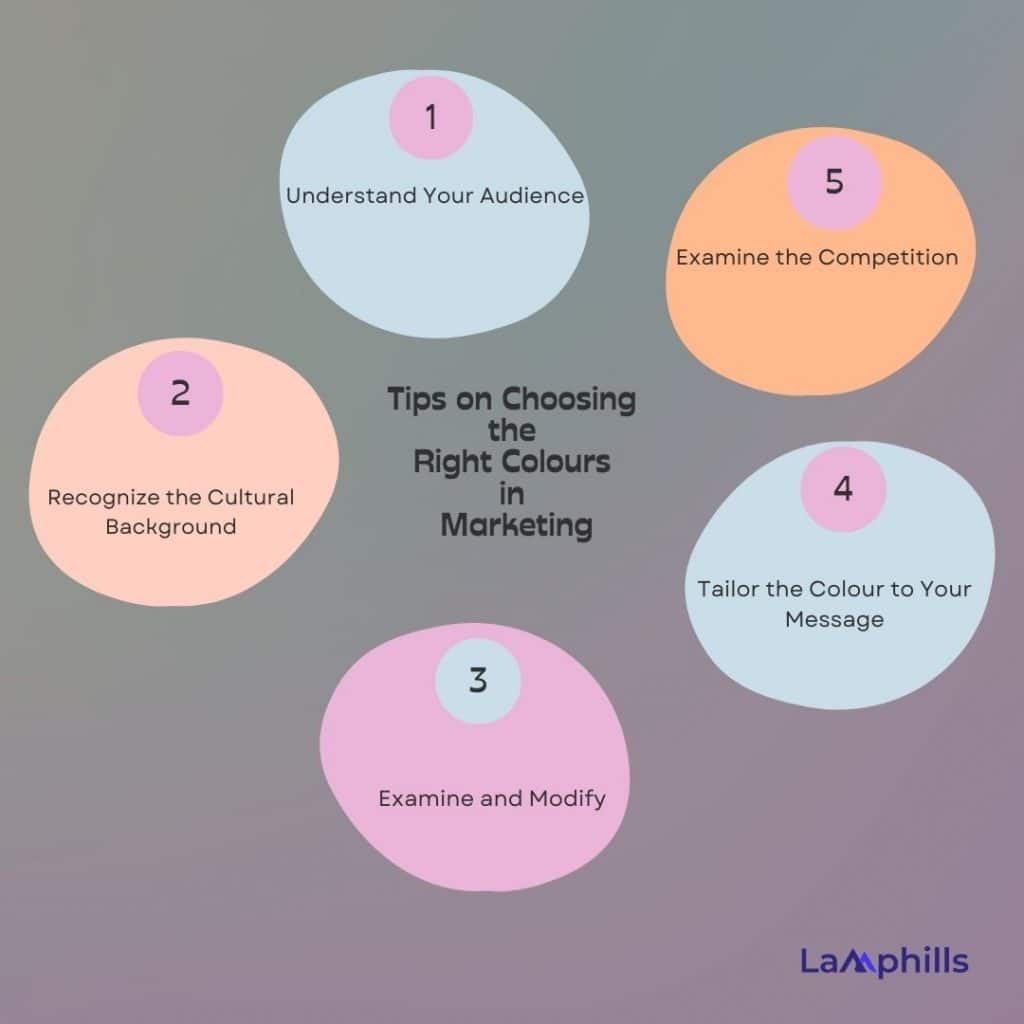Different colours prompt different emotions. Discover how to employ colour in your marketing strategy to attract consumers and build your brand. When I initially started working in marketing, I was preoccupied with the language, imagery, and tactics employed in each campaign. Not until I worked on a few unsuccessful projects did I discover that colour was a vital component that was lacking. I realised that although the incorrect colours could ruin a brand and its message, the right ones could enhance it. It turns out that colour significantly influences how consumers view and engage with a brand. I would like to relate my personal experience of how colours in marketing can make or break a campaign since I have had both successes and failures with colour over the years. The psychology of colour in branding and marketing is covered in this article.
Key Points
- Emotions are influenced by colour; for example, red conveys urgency, blue fosters trust, and green represents health.
- The target market and brand goals determine the “best” colour, which is not a single colour.
- Colour in advertising attracts attention, evokes strong feelings, and strengthens brand identity.
- The “Law of Colour” stresses the need to choose unique colours to differentiate oneself from rivals.
- Choosing colours carefully for international advertising is essential since different cultures have unique interpretations of colour.
Overview
Colour may have a significant impact on marketing, whether you are aware of it or not. Whether they are aware of it or not, your audience is emotionally impacted by the colours you choose in your branding, including your logo and other marketing materials. The best marketing colours are essential if you want to create a powerful campaign. Understanding the significance of particular colours might be useful because there are many colours you can use. You may therefore use colour psychology to your advantage and communicate with your target audience more easily.
The colour that works best for one product or service may not work well for yours. Since every colour has a certain meaning, you need to think about how some colours will complement your brand. This guarantees that you can position your marketing effort for maximum success.
I thought that language, images, and customer service were the only factors that could make a brand successful when I first started working in marketing. I had no idea how important colours are to a brand’s performance and impression. Colours are an essential component of branding, not only an afterthought, as I discovered after working on numerous campaigns and brand-building initiatives.
I have had wins along the way, but I have also gained important knowledge from my mistakes. It is now obvious that while the wrong colours can confuse, disengage, or even discourage consumers, the right ones can elevate a brand and solidify its place in its thoughts.
Also Read: Top 15 Strategies to Increase Your Brand Awareness
Colours in Marketing and Branding
Your identity and marketing are based on the colours you choose. These will be used to design your logo, website, advertisements, and much more; therefore, you should not take them lightly. The colours you use for your branding and marketing should be intelligently chosen instead.
In addition to being visually pleasing, colours are effective instruments for building brand recognition. Consider the world’s most prosperous brands. The red of Coca-Cola, the yellow of McDonald’s, or the green of Starbucks are readily identifiable even without their logos. When a brand uses colours consistently, it becomes remembered. People gradually come to identify certain colours with particular businesses or goods, sometimes without even recognizing them.
I also helped to establish a new IT company as part of a different venture. At first, its branding used silver and blue tones, which are safe, businesslike colours that are commonly used by tech organizations. However, I required a more daring way to distinguish them. I suggested adding a bright yellow to go with the blue.
The mix worked, even though yellow isn’t usually linked with technology, so it initially appeared unsafe. Blue kept things professional and trustworthy, while yellow added a dash of creativity and hope. The brand’s fresh, colourful look instantly won many customers. Their brand gained recognition in the competitive market.
Psychology of Colours in Marketing
The psychological impact of colour is among the most interesting marketing things I’ve ever learned. Although colour is sometimes considered merely a visual component, I have found that it has a significant impact on consumers’ perceptions, feelings, and even purchasing decisions. As I’ve experimented with different colours in different campaigns over the years, I’ve come to realize that colour is more than simply decoration; it’s a quietly conveyed message that influences consumers’ perceptions of businesses.
Knowing that every colour creates an emotional response will help you influence how consumers perceive your company or line of goods. This work is something I’ve seen done on a lot of different tasks. The influence of colour on the mind was among the most significant lessons I was taught early on. The associations and feelings that particular colours arouse can have a big impact on how people view a brand.
I’ve discovered that while working on a brand, it’s essential to comprehend these associations. In a project involving a financial services organization, for example, I recognized that blue would be the most effective colour to communicate stability and confidence. I tended to use deep purples and gold to convey majesty and elegance when I worked with a beauty company. Building a great identity requires connecting the brand’s principles with the distinct stories that each colour choice can convey. I consider the following instances when selecting the psychology of colours for branding in marketing:
#1. Red
Among the most powerful colours is red. It is commonly used in sales advertising and fast-food branding because it evokes feelings of excitement, urgency, and joy. Red is what I choose whenever I want to draw attention right away. Balance is essential, though, since I’ve also discovered that too much red can come across as hostile.
#2. Blue
Blue feels trustworthy and soothing. The fact that banks, IT firms, and healthcare brands frequently utilize blue to communicate dependability and security is no accident. When I worked for a financial services company, they immediately gave their clients a sense of security and trust by changing their branding to a deep blue.
#3. Green
Green represents growth, nature, and health. It’s ideal, in my opinion, for wellness and eco-friendly brands. I selected various tones of green to represent an environmentally sensitive message for a sustainable fashion firm I helped create, and it struck a powerful connection with the target audience.
#4. Yellow
Yellow is a colour that exudes vitality, warmth, and optimism. Although it draws attention, I’ve discovered that utilizing it excessively can seem overwhelming. In one marketing effort I oversaw, we used yellow sparingly to give the brand a cheerful, energizing boost and to make it seem more approachable.
#5. Black
Black is a powerful, beautiful, and classy colour. Also, black is frequently used by premium brands to convey luxury. I’ve utilized it in fashion advertisements that sought to convey exclusivity and courage, and it consistently elevated the brand’s image.
#6. Purple
Purple is a colour associated with elegance, prosperity, and creativity. I’ve utilized it in advertisements for high-end cosmetics brands, and it’s frequently connected to high-end goods. The product’s prestige was instantly enhanced by the colour, which gave it a more wealthy vibe.
How Colours Can Make or Break Your Marketing Campaigns
One potent component of marketing strategies that has a significant impact on efficacy is colour. While making the wrong colour selections can turn off potential customers, making the right colour choices can increase engagement and drive sales. Developing effective marketing tactics requires an understanding of the influence of colour.
Even while I’ve had success with colour schemes, I’ve also witnessed how a poor choice can harm a company. I recall working on a project where I decided to use red as the primary colour for a campaign that promoted a health app. Instead of making the campaign feel overly forceful and out of place in the setting of health and wellbeing, as I had anticipated, red would build urgency and draw attention. Red was not a soothing or comforting colour for something intended to promote well-being, according to customer feedback.
I changed course swiftly and used gentle blues and greens to rework the ad. They were very different. Positive user reactions were significantly more common, and engagement skyrocketed. While colours can help a business flourish, I learned from this experience that poor colour selections can confuse or even turn off potential customers. Your colours in marketing campaigns can make or break based on the following:
#1. Instant Attention
A well-chosen colour immediately draws attention. Muted colours may be overlooked in a crowded area, but vivid, striking colours can stick out.
#2. Brand Alignment
Colours ought to convey the message of the brand. Mismatches can lead to consumer confusion. Bright colours are appropriate for a lighthearted, humorous brand, but more serious financial institutions may choose to employ more muted colours.
#3. Emotional Resonance
Emotions evoked by colours can affect consumer behaviour:
- Red: Perfect for sales since it creates urgency.
- Yellow: Optimistic and ideal for positive campaigns.
- Black: It is a colour that successfully conveys luxury in high-end goods.
- Blue: Fit for financial services, it conveys confidence.
- Green: Good for wellness brands because it’s connected to health.
#4. Long-Term Recognition
Over time, consistent colour utilization increases brand recognition. Because familiarity fosters loyalty and trust, customers are more inclined to select your brand.
#5. Cultural Awareness
Worldwide, different colours have different meanings. Marketing errors may result from a failure to comprehend cultural meanings. For example, in certain Asian cultures, white represents sadness, yet in the West, it represents purity.
#6. Evaluation and Feedback
You can make data-driven decisions by using A/B testing to determine which colour schemes your audience responds to the most.
Tips on Choosing the Right Colours in Marketing
It takes more than simply style or beauty to choose the proper colours. It all comes down to strategy. The following are some essential guidelines I adhere to when choosing colours for a brand in marketing:
#1. Understand Your Audience
I discovered early on that different colours appeal to different groups of people. When speaking to a younger audience, I frequently choose vibrant, upbeat colours like green or yellow. If the objective is more business-oriented or professional, I tend to use subdued, elegant colours like black or blue.
#2. Recognize the Cultural Background
Cultures can differ greatly in their interpretations of colour. When I work on advertising for global audiences, I always consider how people’s perceptions of colour change. For instance, while white is frequently used to represent purity in Western civilizations, it is also connected to grief in several Eastern traditions. I’ve avoided making serious marketing mistakes because I am aware of these cultural variances.
#3. Examine and Modify
I’ve discovered that you don’t always get things perfect the first time around. I constantly experiment with colour schemes before committing to a campaign because of this. To find out how different colours work for engagement and conversions, I use A/B experiments. Occasionally the outcomes take me by surprise, and I choose a shade that I didn’t think would work as well as it did.
#4. Tailor the Colour to Your Message
The colour palette I choose must always be in line with the point I wish to make. Bright pinks and oranges are cheerful colours that I use when I’m marketing a product that’s supposed to be carefree and enjoyable. I choose darker blues and greys, though, if the objective is to establish professionalism and trust. Each campaign has a tone, and the colour scheme ought to appropriately convey that tone.
#5. Examine the Competition
I usually consider my competitors’ colour schemes when designing my own. My campaign blending in with theirs is the last thing I want. All of the competition was utilizing soft colours when I worked on a cosmetics brand commercial. To create an advertisement, I used a vibrant colour with jewel tones, and it was successful. The advertising succeeded better than anticipated, not merely getting attention.

The Importance of Colour in Marketing
One thing I’ve discovered in my work in marketing is that colours are more than just a matter of preference. They have an impact on people’s emotions, perceptions of a brand, and even their propensity to behave. Whether I’m creating a marketing campaign or a brand identity, colour has emerged as one of my most crucial tools.
A modest but expanding health company asked me to update their identity a few years into my career. In a congested market, they found it difficult to stand out despite having a respectable range of goods and services. Their initial colour scheme, a dull mix of brown and grey, said nothing about the living, organic energy that their products provided. I made the decision that their brand’s visual identity needed to be completely changed. The colours I chose are gentle green and light blue, which are linked to peace, health, and the natural world.
It had an immediate effect. Along with the company’s message becoming more apparent, consumers also started to identify the brand with calmness, purity, and well-being. Marketing and sales were starting to rise. I initially became aware of how strongly colours affect consumers’ perceptions of a brand at this point. In branding, colour is an essential element that shapes perception, arouses feelings and contributes to the development of a powerful identity. A brand’s success can be greatly impacted by the colours chosen. The following highlights the impact of colour in marketing:
#1. First Impressions
Colours are instantly recognizable. A powerful colour scheme can help a brand become instantly recognizable.
#2. Brand Recognition
Colour amplifies brand ideals. For instance, greens are frequently used by environmentally conscious companies to symbolize their dedication to sustainability.
#3. Cultural Significance
Cultural differences in colour meanings might impact a brand’s global perception. International branding requires an understanding of these distinctions.
#4. Emotional Bonding
Numerous colours arouse distinct emotions:
- Red: Intense and passionate.
- Yellow: Vibrancy and hope.
- Black: A colour of refinement and wealth.
- Blue: Dependability and trust.
- Green: Health and the environment.
- Purple: Wealth and creativity.
#5. Consistency Across Channels
Maintaining brand identification across several platforms using a consistent colour scheme improves recognition and trust.
#6. Differentiation in the marketplace
A company can differentiate itself from competitors in a crowded market by using unique colour schemes.
Also Read: Graphic Design Trends: Top 15 Best in 2024 You Should Know for Your Social Media.
What do colors mean in marketing?
Specific feelings and perceptions are evoked by colours in marketing, which affects consumer behaviour. The following is a little explanation:
- Red: Passion, urgency, and excitement; frequently used in fast-food and sales advertisements.
- Blue: Trust, dependability, and harmony are frequently used by IT and financial services firms.
- Green: It is ideal for sustainable and wellness brands since it represents peacefulness, nature, and health.
- Purple: It is associated with exclusivity, inventiveness, and wealth; it complements high-end makeup.
- Yellow: The colour yellow draws attention and makes people feel happy.
- Black: Used in luxury companies and high-end apparel, it symbolizes power, refinement, and luxury.
Which color is best for marketing?
The “best” colour for marketing doesn’t exist; instead, it all relies on the company’s goals and target market. But because it promotes reliability and confidence, blue is widely used and adaptable to a variety of businesses. Particularly in retail and fast-moving consumer items, red and yellow are very well-liked for drawing attention and encouraging action.
What is the role of color in advertising?
The use of colour in advertising is essential because:
#1. Raising Interest
Vibrant colours such as yellow and red immediately draw in onlookers.
#2. Boosting Brand Recognition
Brand loyalty and recognition are increased by consistent colour utilization.
#3. Influencing Decision-Making
Colours have the power to motivate consumers to act; for example, red action buttons (fire alarm) may evoke a sense of haste.
#4. Developing Emotional Bonds
Because colours arouse particular feelings in people, marketers can establish a stronger connection with their target market.
What is the law of color in marketing?
According to the “Law of Colour” in marketing, companies trying to stand out should employ colours that are different from those of their rivals. It highlights differentiation—setting a company apart with a distinctive colour scheme prevents misunderstanding and increases brand recall in consumers’ thoughts. Given that colour serves as a rapid visual cue for brand recognition in crowded markets, this idea is especially crucial.
Conclusion
My experiences have led me to believe that one of the most important elements of branding is colour. It can influence opinions, evoke feelings, and specify how a brand is recalled. Through diligent colour selection and testing, I have helped brands create a distinctive identity, connect with their target consumers, and stand out in crowded markets. Whether you’re creating a new brand or updating an old one, keep in mind that the appropriate colours might be your greatest strength. Looks are important, but so is what seems appropriate for the message you’re attempting to convey. The first step to building a brand that endures is realizing the power of colour, which can make or break a company.
Related Articles
- What is Brand Marketing? Understanding the Essentials for Building Strong Brands
- Brand Book: 7 Best Brand Book Examples for Your Inspiration + How to Create One
- Brand Awareness Campaign Examples: 10 Effective Examples (+ Tips)
- Successful Brand Repositioning Examples: How Companies Reinvented Themselves
- 7 Types of Branding: How to Choose the Right Strategy for Your Business






